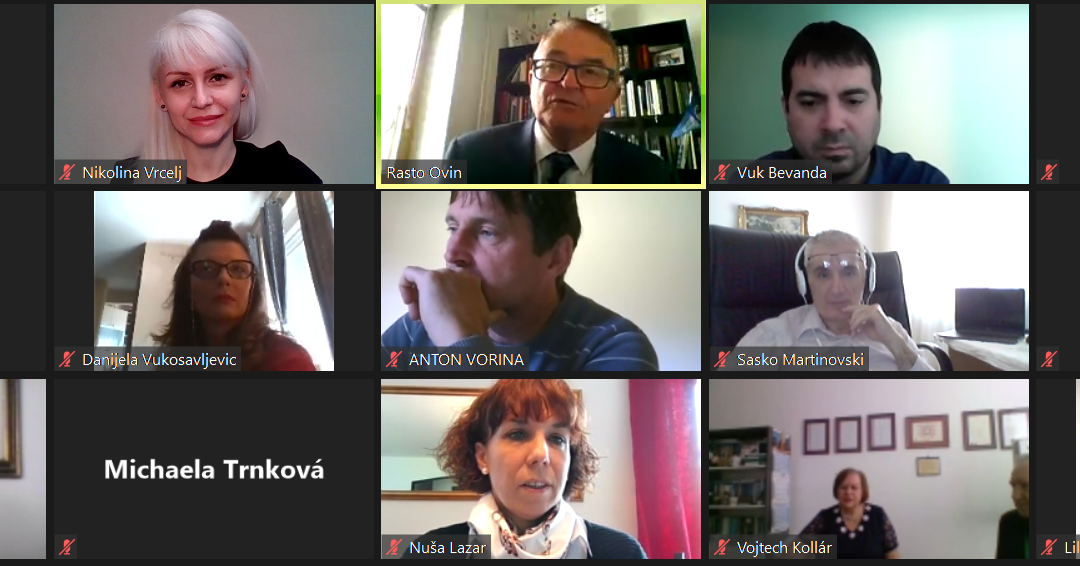Financial Life Cycle of Kosovo SMEs: Results of an Enterprise Survey
Argjentë Qerimi – University of Pristina, Faculty of Economy, Rr. Agim Ramadani, p.n.10000, Pristina
Muhamet Aliu – University of Pristina, Faculty of Economy, Rr. Agim Ramadani, p.n.10000, Pristina
Besnik Krasniqi – University of Pristina, Faculty of Economy, Rr. Agim Ramadani, p.n.10000, Pristina
7th International Scientific ERAZ Conference – ERAZ 2021 – Selected Papers: KNOWLEDGE BASED SUSTAINABLE DEVELOPMENT, Online/virtual, May 27, 2021
ERAZ Conference Selected Papers are published by: Association of Economists and Managers of the Balkans – Belgrade, Serbia
ERAZ conference partners: Faculty of Economics and Business, Mediterranean University, Montenegro; University of National and World Economy – Sofia, Bulgaria; Faculty of Commercial and Business Studies – Celje, Slovenia; AMBIS University, Prague – Czech Republic; Faculty of Applied Management, Economics and Finance – Belgrade, Serbia
ERAZ Conference 2021 Selected Papers ISBN 978-86-80194-47-9, ISSN 2683-5568, DOI: https://doi.org/10.31410/ERAZ.S.P.2021
Keywords:
Financial growth cycle;
Small business finance;
SMEs;
Kosovo
Abstract: This article empirically examined how Kosovan SMEs finance their working capital and their investments through their growth life cycle. Using the financial growth cycle paradigm to test the financial growth cycle based on a sample of 100 Kosovan SMEs’ reporting data since their inception of business. Findings show that Kosovan SMEs use various sources to finance their working capital and investments throughout their life cycle. To finance their working capital needs, during the first two years of operation, Kosovan SMEs rely more on insider capital sources such as personal savings, financing offered from 3F connection – friends, family, fools, retained earnings, and also trade credit takes a significant place. Over time, as businesses evolve through age, the proportion of retained earnings and business debt financing in total capital injection volume increases significantly. As firms grow older, financing from trade credit marks a decline, so the SMEs replace it with using more overdraft. During the first years of operation, to finance their investments, Kosovan SMEs rely primarily on owner’s personal savings, financing from 3F connection – friends, family, and fools, retained earnings, but as the company grows older and becomes more extensive, they rely mainly on two sources: retained earnings and bank loans. In general, concerning debt, Kosovan SMEs use more trade credit and overdraft to finance their working capital and bank loans to finance their investments. Funding from 3F is mainly used during the initial phase of operation. However, the most used resource by Kosovan SMEs in all stages of operation remains retained earnings, while external equity raised from angels and venture capitalists and other alternative financing are almost inexistent

ERAZ Conference
Creative Commons Non Commercial CC BY-NC: This article is distributed under the terms of the Creative Commons Attribution-Non-Commercial 4.0 License (https://creativecommons.org/licenses/by-nc/4.0/) which permits non-commercial use, reproduction and distribution of the work without further permission.

References
Ang, J. S. (1992). On the Theory of Finance for Privately Held Firms. The Journal of Entrepreneurial Finance, 1(3), 185–203.
Bakhtiari, S., Breunig, R., Magnani, L., & Zhang, J. (2020). Financial Constraints and Small and Medium Enterprises: A Review*. Economic Record. https://doi.org/10.1111/1475- 4932.12560
Barton, S. L., & Gordon, P. I. (1987). Corporate Strategy: Useful Perspective for the Study of Capital Structure? Academy of Management Review. https://doi.org/10.5465/amr.1987.4306479
Beck, T. (2007). Financing Constraints of SMEs in Developing Countries : Evidence , Determinants and Solutions. Financing Innovation-Oriented Businesses to Promote Entrepreneurship.
Bondareva, I., & Zatrochová, M. (2014). Financial Support for the Development of SMEs in the Slovak Republic. Procedia – Social and Behavioral Sciences, 110, 541–548. https://doi. org/10.1016/j.sbspro.2013.12.898
Bridge, S., O’Neill, K., & Cromie, S. (1998). Understanding Enterprise, Entrepreneurship and Small Business. In Understanding Enterprise, Entrepreneurship and Small Business. https://doi.org/10.1007/978-1-349-26171-0
Cassar, G. (2004). The financing of business start-ups. Journal of Business Venturing, 19(2), 261–283. https://doi.org/10.1016/S0883-9026(03)00029-6
Cempakasari, E. P., Firdaus, M., & Hardiyanto, A. T. (2019). Dynamics of Firm’s Capital Structure Along The Life Cycle of Indonesian Manufacturing Firms. Indonesian Journal of Business and Entrepreneurship, 5(1), 21–31. https://doi.org/10.17358/ijbe.5.1.21
Chittenden, F., Hall, G., & Hutchinson, P. (1996). Small firm growth, access to capital markets and financial structure: Review of issues and an empirical investigation. Small Business Economics, 8(1), 59–67. https://doi.org/10.1007/BF00391976
Coleman, S. (2000). Access to capital and terms of credit: A comparison of men-and women-owned small businesses. In Journal of Small Business Management.
Culkin, N., & Simmons, R. (2018). Study of the challenges that hinder msme development in bosnia and herzegovina.
European Commission. (2019). Annual Report on European SMEs 2018 / 2019. In Annual Report (Issue November). https://op.europa.eu/en/publication-detail/-/publication/b6a34664- 335d-11ea-ba6e-01aa75ed71a1/language-en/format-PDF/source-search
European union. (2020). 2019 SBA Fact Sheet. 1–17. https://www.google.com/url?sa=t&rct=j&q=&esrc=s&source=web&cd=&ved=2ahUKEwii_7O4uozuAhXQzYUKHWbXCcMQFjAAegQIBBAC&url=https%3A%2F%2Fec.europa.eu%2Fdocsroom%2Fdocuments%2F38662%2Fattachments%2F2%2Ftranslations%2Fen%2Frenditions%2Fnative&usg=AOvVaw2dFxhsObZz
Gaskill, L. R., Van Auken, H., & Manning, R. (1993). A Factor Analytic Study of the Perceived Causes of Small Business Failure. Journal of Small Business Management.
Getter, D. E. (2020). Small business credit markets and selected policy issues. In Key Congressional Reports for August 2019: Part I.
Hashi, I., & Krasniqi, B. A. (2011). Entrepreneurship and SME growth: Evidence from advanced and laggard transition economies. International Journal of Entrepreneurial Behaviour & Research. https://doi.org/10.1108/13552551111158817
Hauser, P., Dolgaya, T., Revenko, S., & Kortenbusch, M. (2016). Assessment of financing needs of SMEs in the Western Balkans countries – Synthesis Report.
Hussain, J., & Matlay, H. (2007). Financing preferences of ethnic minority owner/managers in the UK. Journal of Small Business and Enterprise Development, 14(3), 487–500. https:// doi.org/10.1108/14626000710773565
Hutchinson, J., & Xavier, A. (2006). Comparing the impact of credit constraints on the growth of SMEs in a transition country with an established market economy. Small Business Economics. https://doi.org/10.1007/s11187-005-4412-3
Huyghebaert, N., & Van De Gucht, L. M. (2007). The determinants of financial structure: New insights from business start-ups. In European Financial Management. https://doi. org/10.1111/j.1468-036X.2006.00287.x
Jones, R. G. (1979). Analysing initial and growth financing for small business. management accounting. Management Accounting.
Kimhi, A. (1997). Intergenerational Succession in Small Family Businesses: Borrowing Constraints and Optimal Timing of Succession. Small Business Economics. https://doi. org/10.1023/A:1007987731337
Krasniqi, B. A. (2010). Are small firms really credit constrained? Empirical evidence from Kosova. International Entrepreneurship and Management Journal. https://doi.org/10.1007/ s11365-010-0135-2
Krasniqi, B. A. (2012). Entrepreneurship and small business development in Kosova. Entrepreneurship and Small Business Development in Kosova, January 2012, 1–239.
Krasniqi, B. A. (2007). Barriers To Entrepreneurship and Sme Growth in Transition: the Case of Kosova. Journal of Developmental Entrepreneurship, 12(01), 71–94. https://doi. org/10.1142/s1084946707000563
Krasniqi, B. A., & Desai, S. (2016). Institutional drivers of high-growth firms: country-level evidence from 26 transition economies. Small Business Economics. https://doi.org/10.1007/ s11187-016-9736-7
la Rocca, M. L., la Rocca, T. L., & Cariola, A. (2011). Capital Structure Decisions During a Firm’s Life Cycle. Small Business Economics. https://doi.org/10.1007/s11187-009-9229-z
Lajqi, S., & Krasniqi, B. A. (2017). Entrepreneurial growth aspirations in challenging environment: The role of institutional quality, human and social capital. Strategic Change. https:// doi.org/10.1002/jsc.2139
López-Gracia, J., & Sogorb-Mira, F. (2008). Testing trade-off and pecking order theories financing SMEs. Small Business Economics, 31(2), 117–136. https://doi.org/10.1007/s11187- 007-9088-4
Mabrouk, L., & Boubaker, A. (2019). The pecking order theory and life cycle: Evidence from French firms. Corporate Ownership and Control, 16(3), 20–28. https://doi.org/10.22495/ cocv16i3art2
Saranda, L., Florin, P.&Besnik, K.(2019). Mapping business start-up ecosystem in Kosovo. Ekonomski Vjesnik / Econviews : Review Of Contemporary Business, Entrepreneurship And Economic Issues,32(2),477-486.
Moder, I., & Bonifai, N. (2017). Access to finance in the Western Balkans. ECB Occasional Paper. https://doi.org/10.2866/742104
Myer, S. C. (1984). The Capital Structure Puzzle. The Journal of Finance, 39(3), 575–592.
- Berger, A., & F. Udell, G. (1998). The economics of small business finance: The roles of private equity and debt markets in the financial growth cycle. Journal of Banking and Finance, 22(6–8), 613–673. https://doi.org/10.1016/S0378-4266(98)00038-7
OECD. (2020). Financing SMEs and Entrepreneurs 2020. In OECD.
Star, A. D. (1983). The Economics of Small Firms (Book Review). Journal of Small Business Management.
Stiglitz, B. J. E., & Weiss, A. (1981). Credit Rationing in Markets with Imperfect Inform. The American Economic Review.
Welsh, J., & White, J. (1991). A Small Business is not a Little Big Business. Harvard Business Review.
Wu, J., Song, J., & Zeng, C. (2008). An empirical evidence of small business financing in China. Management Research News. https://doi.org/10.1108/01409170810920666
https://www.bankassoc-kos.com

